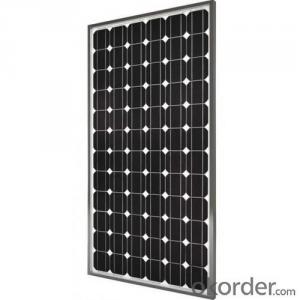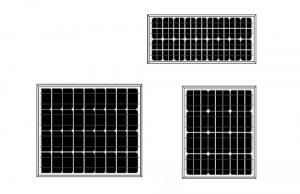Bi Solar Panels - Off-grid Solar Panel TDB125×125/4-36-P Lower Weight Design
- Loading Port:
- Ningbo
- Payment Terms:
- TT OR LC
- Min Order Qty:
- 100 carton
- Supply Capability:
- 10000 carton/month
OKorder Service Pledge
OKorder Financial Service
You Might Also Like

Specification:
· Highest performance enabled by higher efficiency monocrystal line cells and the latest Solar Wafer Technology for multicrystal line cells
· Lower weight design which reduces the total system load on a roof, making it ideal for residential customers. Its shape allows for better roof utilization
· Its low weight means easier handling for installers
· Modules are designed to withstand PID (Potential Induced Degradation)*
· High light transmission Anti-Reflective Glass with improved self-cleaning capability
· 0/+5 W Positive power tolerance for reliable power output
Warranty
CNBM Solar provides one of the most comprehensive module warranties in the industry:
· 10 years for product defects in materials and workmanship
· First 12 years for 90% of warranted minimum power
· Remaining 25 years for 80% of warranted minimum power
Certification
CNBM Solar strictly carries out the ISO 9001 quality control methodology and has implemented check points at every step of the production process to ensure our product performance durability and safety. The stringent quality control process has been confirmed by numerous independent agencies and LDK Solar modules earned IEC, TUV and UL certifications.
· IEC:IEC 61215, IEC 61730 (1&2), conformity to CE
· UL 1703 2002/03/15 Ed:3 Rev:2004/06/30
· ULC/ORD-C1703-01 Second Edition 2001/01/01
· UL and Canadian Standard for Safety Flat-Plate
· ISO 9001: 2008 Quality Management Systems
· CEC Listed: Modules are eligible for California Rebates
· PV Cycle: Voluntary module take back and recycling program
· MCS Certificate



FAQ
1. How do I decide which system is right for me ?
For protection from long outages, include a generator or solar panels in your Must solar system. Shorter outages can be handled by a battery-only system.
2. Where my system will be installed ?
Must solar systems are usually wall-mounted near a home's main electrical (circuit breaker) panel.
3. How do I install my system ?
A must solar backup inverter is connected to a home electric system , we will supply detailed installation manual and videos for our customers .
How fast will my system respond to a power outage ?
Must solar inverters typically transfer to battery power in less than 16 milliseconds (less than 1/50th of a second).
What kind of batteries do the systems include ?
Must solar backup electric systems use special high-quality electric storage batteries.
- Q: I'm about to buy one but I don't really know which one is best for my home.
- Talk okorder has good info. What state are you in?
- Q: Can solar panels be used in areas with high levels of dust or sandstorms?
- Yes, solar panels can be used in areas with high levels of dust or sandstorms. However, frequent and heavy exposure to dust or sand can reduce their efficiency over time. Regular cleaning and maintenance are necessary to ensure optimal performance in such areas. Additionally, advanced solar panel designs and coatings are being developed to mitigate the impact of dust and sand accumulation, making them more suitable for use in these challenging environments.
- Q: What is the average annual energy output of solar panels that can be installed on the home?
- Average Solar Panel Output
- Q: We are thinking about useing solar panels for our house.Does anyone know about solar panels? If so could you please tell me some information on them,and the cost for a home,to install them.
- solar panels are device that convert sun energy into electric energy by physic and chemical effect.solar panels price is high,but you will save your late electricity bill,it is cost effictive.
- Q: I want to be more green and if I get the panels will I still have a regular electric bill?
- The most cost-effective solution, which the vast majority of new installs use today, is solar alongside the regular power company. That way, you need no batteries, and if the solar array isn't producing enough at any given time, you draw from the electric company. When the array is producing more than you need, instead of just throwing that power away, the power company buys it (usually). In short, yes, you will still have an electric bill, but a smaller one. On our house, the electric bill was a little less than $5 a month, with an end-of-year settlement of an additional $2. How much does it cost? Unfortunately, that's like asking how much personal transportation costs. Some people need a van to transport the kids to soccer, some may get by with a motorcycle, others may need only a bicycle. The best thing is to contact a professional installer to get a quote based on your location and electrical usage. Solar electric does not make financial sense in all areas. Our array cost $2,000 but don't use that as a guide. Yours might be 0 times that, or half that, depending on your area and needs.
- Q: I am interested in solar energy, but am not sure how eficiant it would be in the northwest? Any comments would be apriciated.
- If you have southern exposure . Go for it.
- Q: Can solar panels be installed on parking lots?
- Yes, solar panels can be installed on parking lots. In fact, it is becoming increasingly common to install solar panels on parking lots as it allows for optimal utilization of available space while generating clean and renewable energy. Additionally, solar panels installed on parking lots can provide shade, reduce heat island effect, and serve as electric vehicle charging stations, making it a sustainable and efficient solution.
- Q: I know there's different brands of solar panels and they cost different amounts.But if anyone know the average price of one solar panel could you help me out?Also could you please list the size of the solar panel.
- That okorder
- Q: Can solar panels be used to power swimming pools?
- Yes, solar panels can indeed be used to power swimming pools. Solar panels can generate electricity from sunlight, which can be used to operate pool pumps, heaters, and other equipment, reducing the reliance on traditional electricity sources and saving on energy costs.
- Q: how would you build a solar panel
- i'd go to the solar panel store and buy one. It would be /0 the cost of trying to build one in my HOME shop.
Send your message to us
Bi Solar Panels - Off-grid Solar Panel TDB125×125/4-36-P Lower Weight Design
- Loading Port:
- Ningbo
- Payment Terms:
- TT OR LC
- Min Order Qty:
- 100 carton
- Supply Capability:
- 10000 carton/month
OKorder Service Pledge
OKorder Financial Service
Similar products
Hot products
Hot Searches
Related keywords




























